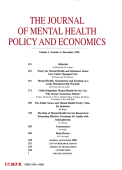|
Background: Nearly half of
all US workers have access to an employee assistance plan (EAP). At the same
time, most large US employers also purchase health benefits for their
employees, and these benefits packages typically include behavioral health
services. There is some potential overlap in services covered by the EAP and
the health plan, and some employers choose to purchase the two jointly as an
`integrated product'. It is not clear whether EAP services substitute for outpatient
behavioral health care services covered by the health plan.
Aim of the Study: To evaluate how
the number of EAP visits covered affects the use of regular outpatient
behavioral health care (number of visits, and total spending), in an integrated
product setting.
Methods: Analysis of
claims, eligibility and benefits data for 26,464 users of behavioral health
care for the year 2005. For both EAP and regular behavioral health care, the
individuals were enrolled with Managed Health Network (MHN), a large national
specialty insurance plan. Multivariate regression analyses were performed to
investigate the determinants of the number of regular outpatient visits, and
spending for regular outpatient care. To address skewness in the dependent
variables, the estimation used generalized linear models with a log link. A
limited instrumental variable analysis was used to test for endogeneity of the
number of EAP visits covered.
Results: Nearly half the
enrollees in this sample were in employer plans that allowed 4-5 EAP visits per
treatment episode, and 31% were allowed 3 EAP visits per year. Having an EAP
visit allowance of 4-5 sessions per episode predicts fewer regular outpatient
visits, compared with having an allowance of 3 sessions per year. More generous
EAP allowances also reduce payments for outpatient care, with one exception.
Discussion: Greater
availability of EAP benefits appears to reduce utilization of regular
outpatient care, supporting the idea that the two types of care are to some
extent perceived as substitutes. One limitation of this study is its
cross-sectional nature, since the relationships observed could reflect the
effect of other unmeasured variables. Also, the data are from a single managed
behavioral health organization, limiting generalizability somewhat, although
many employers are represented in the data.
Implications for Health Policy: The
results should discourage employers from either eliminating EAP benefits as
duplicative, or replacing behavioral health benefits with an expanded EAP.
Patients appear to perceive that EAP services offer something distinct from
regular outpatient care.
Implications for Further Research: Future studies should see whether these results are reproduced, ideally by
looking at employer plans with a wider range of EAP visit allowances. |
